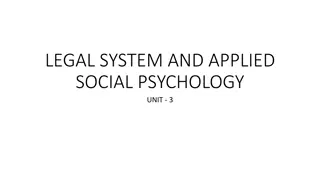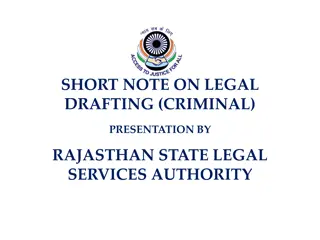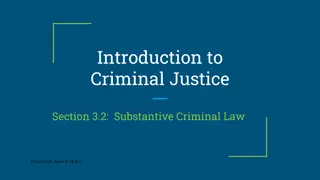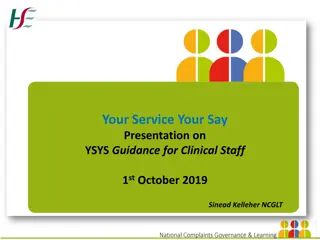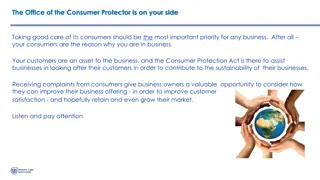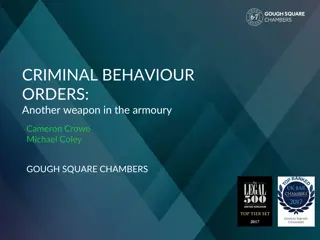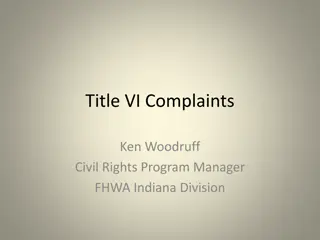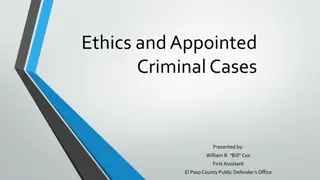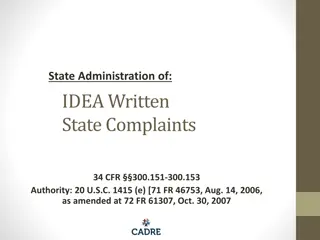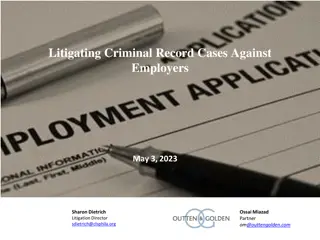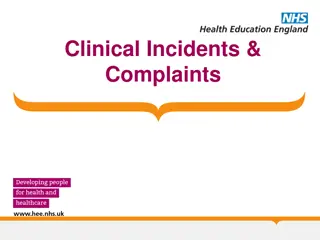Understanding Civil and Criminal Complaints in Legal Cases
Explore the distinctions between civil and criminal complaints in legal scenarios. Learn how a civil case seeks monetary damages while a criminal case pursues punishment for wrongful actions. Understand the roles of plaintiffs and prosecutors, burden of proof, and outcomes in both civil and criminal cases.
Download Presentation

Please find below an Image/Link to download the presentation.
The content on the website is provided AS IS for your information and personal use only. It may not be sold, licensed, or shared on other websites without obtaining consent from the author. Download presentation by click this link. If you encounter any issues during the download, it is possible that the publisher has removed the file from their server.
E N D
Presentation Transcript
The Elements of a Mock Trial Kimberley Stuart, Esquire 1
HOW TO DEVELOP A MOCK TRIAL CASE BEFORE A CASE IS A CASE, IT IS EITHER A DISPUTE OR AN OFFENSE.
EXAMPLE: Mary lends Bob $20 to be returned on January 1. Bob doesn t pay Mary back on January 1. Mary asks for her money back. Bob refuses.
WHAT CAN MARY DO? Mary can ask a Court of Law to help her get her money back. The first step is to file a CIVIL COMPLAINT, demanding money damages ($20.00) from Bob.
CIVIL COMPLAINT The Mary v. Bob case is a CIVIL case because Mary seeks Money Damages.
CRIMINAL COMPLAINT If Mary alleges that Bob took $20 without permission or if Mary alleges that Bob took $20 from her under false pretenses, then the case would be CRIMINAL, because Mary would be alleging that Bob had CRIMINAL INTENT, to take her money.
WHAT CAN MARY DO? Mary can contact her local police department to make a CRIMINAL COMPLAINT against Bob. Bob would be CHARGED with a violation of one or more New Jersey Criminal Statutes. Bob would be PROSECUTED for alleged crimes of theft and/or fraud.
What is the difference between a civil complaint and a criminal complaint? A civil case demands MONEY DAMAGES A criminal complaint demands PUNISHMENT for a wrongful act.
CIVIL V. CRIMINAL A CIVIL case is brought by the PLAINTIFF. A CRIMINAL case is brought by the State or the PROSECUTOR. A CIVIL case requires proof by a PREPONDERANCE of the evidence (more likely than not). A CRIMINAL case requires proof BEYOND A REASONABLE DOUBT (almost certain). A CIVIL case renders the defendant LIABLE to the plaintiff for money damages. A CRIMINAL case renders the defendant GUILTY of a crime for which he will be sentenced (punished) by a judge.
How To Prepare A Law Fair Case Grades 3-6 Diane Jablonowski, Retired Teacher, Washington Township Public Schools
THE PROCESS Hook the students to spark interest short mock trial video The Case of the Stolen Candy Bar: The People vs Joe Jones video - https://www.youtube.com/watch?v=Fm0pIpPQuaU Students discuss what they heard and arrive at a verdict Introduce vocabulary: plaintiff, defendant, witness, lawyer, guilty, not guilty Students discuss why they chose their verdict Explore People in the Courtroom Criminal vs Civil definitions, scenarios Begin to write scenarios and submit to teacher facts vs opinion discussion; balanced (not an obvious outcome; not a slam dunk for either side) Narrow submitted scenarios down and choose one Work on final case scenario collaboratively as a class What is the crime? What law was broken? Is this a civil or a criminal case? Who is the defendant? Who is the plaintiff? Review the mock trial contest rules, sample case
THE PROCESS continued Students break into 2 groups prosecution/plaintiff and defense to determine witnesses and write the witness statements (2 for each side) Together as a class, read and discuss the case; finalize title for the case and all the character names, facts, issue, witnesses, witness statements, instructions, sub issues, concepts, and law (Follow Law Fair Rules Booklet at njsbf.org) Can be funny but relevant names for characters see past winning cases on njsbf.org Make sure the case is BALANCED (not a slam dunk for each side) Before submitting the case, review the case according to the Law Fair Rules booklet at njsbf.org Name of the case - someone vs. someone (can also have a catchy name as well) Elements (include the Element numbers) 1. Facts just facts; not opinions 2. Issue what is the question at hand; what needs to be proven? 3. Witnesses list For the Plaintiff/Prosecution and For the Defense 4. Witness Statements 5. Instructions to inform the jury of what the prosecution/plaintiff must prove 6. Sub-Issues any extenuating circumstances 7. Concepts usually either preponderance of evidence or beyond a reasonable doubt 8. Law can be an actual law or can be made up by class PROOFREAD ! (not just spell check; actually read)
WRITE THE SCRIPT & PRESENT THE CASE Write the script after the case was submitted to the NJSBF Discuss the parts of a trial and the flow Opening statements, witness direct examinations, cross examinations, closing statements/arguments Discuss how to pose a question to witnesses, and leading questions on cross examination Use the case submitted to guide trial questions Students select what role they want Can break up parts so more students can be included Write the dialog (questions and answers) follow the case in order of trial flow Practice role playing keep to 15 minutes make adjustments as needed Present the trial to a sister school or another class or last year s class that did this they would be your jury Ask why the jury chose the verdict they chose Ask what information in the case carried a lot of weight/helped make their decision It is okay to allow students to read from a card or the script less stress It is okay for students to dress up in their role
NJ STUDENT LEARNING STANDARDS NJSLSA.R4.4. Read with sufficient accuracy and fluency to support comprehension. NJSLSA.R4.8. Explain how an author uses reasons and evidence to support particular points in a text. NJSLSA.W4.3. Write narratives to develop real or imagined experiences or events using narrative technique, descriptive details, and clear event sequences. NJSLSA.W4.5. With guidance and support from peers and adults, develop and strengthen writing as needed by planning, revising, and editing. NJSLSA.SL 4.1. Engage effectively in a range of collaborative discussions with diverse partners, building on others ideas and expression their own clearly. NJSLSA.L5.1: Demonstrate command of the conventions of standard English grammar and usage when writing or speaking. NJSLSA.L5.2: Demonstrate command of the conventions of standard English capitalization, punctuation, and spelling when writing. 6.3.8.Civics PR.5: Engage in simulated democratic process (e.g., judicial proceedings) to understand how conflicting points of view are addressed in a democratic society. 6.1.5.Civics CM.3: Identify the types of behaviors that promote collaboration and problem solving with others who have different perspectives.
RESOURCES NJ State Bar Foundation Mock Trial website https://njsbf.org/school-based-programs/mock-trial/ Contest rules, past winning cases Law Fair sample curriculum Mini Court Teacher s Guide includes Case of the Missing Puppy https://njsbf.org/wp-content/uploads/2017/03/k-2-mini-court2000.pdf Mock Trial Exercise and Quiz https://njsbf.org/school-based-programs/mock-trial-civics-online-content/ NJ Courts website examples of statements, testimony, etc. https://www.njcourts.gov/courts/assets/vicinages/essex/Elementary_School_Fact_Pattern_2016.pdf ?c=2Kc
HOW TO DEVELOP A LAW ADVENTURE CASE John Shanagher, Retired Teacher, Bloomfield Middle School
Cases may be civil or criminal, must be original, and must be proofread for content and grammar. All required elements must be included or the case will be disqualified. The judges pick two themes. You must write a case which addresses one of those themes.
Prep Work Time frame: Two to three weeks of using part of several classes per week. I introduced the themes and defined any necessary terms for the class. I then gave them a week to think of a scenario which uses one of the themes. We then reviewed all of the suggestions and made a list of the ones we thought should be further discussed. Once we had narrowed down the field, we broke into groups and tried to develop several of the ideas. After discussion, the students chose which subject was most likely to produce a good case.
Writing the Case Time frame: Hard to say, it can take several weeks or several months depending on how much class time you can spare. I did current events on Friday so I used part or all of that period with the honors class to work on mock trial. I divided the class into three groups: one works on the facts, one works on the plaintiff/prosecution witness statements, one works on the defense witness statements. We compared notes at the end of each session so that all three groups were writing statements that were consistent with each other. Once we had statements and facts completed, we decided the issues, sub-issues, concepts, and law. The instructions are based on whether your case is civil or criminal.
REQUIRED ELEMENTS Facts: This is where you describe what happened. In this part, there should be no bias towards either side, just the undisputed facts which occurred. Issue: Why is this case being brought before the court? Witnesses: Be sure to list only two witnesses for the plaintiff/prosecution and two for the defense. It is important that you not add additional witnesses.
Required Elements Continued Witness Statements: This is where the facts get slanted towards one side or the other. The testimony cannot contradict the facts, but it should present them in the most favorable light for either side. In other words, the testimony of the defense witnesses will help the defense; the testimony of the plaintiff/prosecution witnesses will help their side. Instructions: What must be proved to the jury? Sub-Issues: Any additional aspects of the case which may bear on the jury's decision. Concepts: Educational terms, etc. which help to decide and develop the case. Law: Actual or made-up law which supports one side or the other in your case. You can have fun making up your own laws, but they must not be inconsistent with actual laws.
I know that this looks like a lot of work, and it is, but it was also my favorite activity. The students learn a great deal about the Constitution, civil and criminal law, and current events in the process. They also have a lot of fun. Students who returned to visit years later always brought up their mock trial experience as the highlight of history class.
Response to Frequently Asked Questions Carole B. Moore, Chair, Law Adventure Committee
The Judging Process Explained Frequently asked questions : We have submitted entries in the past, but are we doing them correctly? I attended the workshop in the past but I am unsure if our submissions are done correctly. Can you help me? Is the trial to be written in a story form? Do we include testimony questions and answers? Is there a way to see what a winning entry looks like? Your Go To Place Law Fair/Law Adventure page on NJSBF S website. www.njsbf.org
Submissions must be related to the themes for this specific year. In 2022-2023, the themes for Law Adventure only are Students Rights and Defamation. Student work: A case that raises questions as to whether it was written by students or professionals may require a second look. While many of the cases are submitted by G&T groups or just really capable, creative students, there is a marked difference between student-generated work and work of an attorney or professional. While dialogue with attorneys and professionals is encouraged and helps students understand the process, the product should be that of the students.
There are five basic areas that are most important to keep in mind: 1. Format 2. Balance 3. Length 4. Publication ready 5. Creativity
FORMAT: The format for the submission is well established in the Law Fair/Law Adventure rules booklet, which can be downloaded from our website, njsbf.org. There is a sample in the booklet that illustrates what should be included in each section. The initial submission has several distinct sections. It is very important that the format be followed. This gives students an understanding of how cases are structured. It is not a "story."
Title:Jones v. John Wallace Middle School You can add an interesting title, such as Putting a Lid on Living History. Facts: This section gives the facts of the case. It can be written as a descriptive section with a factual story line to make it interesting. No conclusions are drawn, no testimony, simply facts. Make sure the facts are balanced on both sides. Issue: What is to be investigated and decided upon? This section states the question your case is addressing. Witnesses: Each side is allowed ONLY TWO witnesses. Cases that have less or more witnesses for each side will be disqualified. In this section, list the witnesses and how they are related to the case. For the plaintiff: Mrs. Jones, mother of Tommy, the plaintiff; Mr. Smith, history teacher. For the defense: Roger, student at JWMS, Ms. Harris, guidance counselor.
Witness Statements: For the Plaintiff/ Prosecution: Mrs. Jones [Provide her statement of the facts.] Mr. Smith [Provide his statement of the facts.] For the Defense: Roger [his statement] Ms. Harris [her statement] Instructions: The wording of this section is critical. If the case is civil, the instructions to the jury must include the charge that the plaintiff must prove by a preponderance of evidence that..... If the case is criminal, the prosecution must prove "beyond a reasonable doubt." Cases are often eliminated if this section confuses the charge between civil and criminal instructions.
Sub-Issues: This is a list of facts/questions that should be considered when determining the outcome of the case with the facts presented. Concepts: A list of concepts of law that should be considered. Law: This section is like a bibliography or works cited section: a listing of laws or cases that were referenced in preparing the case or illustrate the law in question. This can be factual or created by the students. Rather than just listing sources, a short description of the case or law should be given. Make sure the law relates to your case.
BALANCE: A balanced case is not tipped one way or the other. Both sides present points to be carefully considered. From the reading, the outcome is not readily apparent. There is the possibility that were this case tried before different juries, the outcomes could change LENGTH: Cases that are too long or too short may affect whether the case moves on in the process. PUBLICATION READY: Well written. Check grammar, spelling, punctuation, syntax, consistency of names, dates, facts. When cases have multiple errors, they are not in a form that can be posted by the State Bar Foundation. Make proofing a class effort. CREATIVITY: Interesting. Many cases present the same set of issues; so, a twist or a creative view will make the case stand out from other cases dealing with similar issues.
If the submission is selected to be presented, that is when the script/dialogue (opening statements, testimony of witnesses, questioning by attorneys and closing arguments) is needed. However, doing this in advance will give you a head start in preparation for presentation, whether at the Law Center or at your school. There are many great examples of winning cases posted on the Law Fair/ Law Adventure page of NJSBF s website. Just click on the links at njsbf.org.
Professional Development Certificates If you attended this workshop, we will email you a link to print out your certificate. We will use the same email and name that you provided when you registered. If you have any questions about the certificates, contact aemerson@njsbf.org. Survey The link to the survey will be emailed to you as well. Please fill out the survey to receive your professional development certificates.
Questions? Please contact Sheila Boro, director of Mock Trial Programs, at sboro@njsbf.org.


